Why you can trust Tom's Hardware
The PD32M has multiple game and picture modes. Combining them can get confusing if you’re not careful. My suggestion: leave the Eco mode on Standard and turn the Game Mode off. Then calibrate from there.
Grayscale and Gamma Tracking
Our grayscale and gamma tests use Calman calibration software from Portrait Displays. We describe our grayscale and gamma tests in detail here.


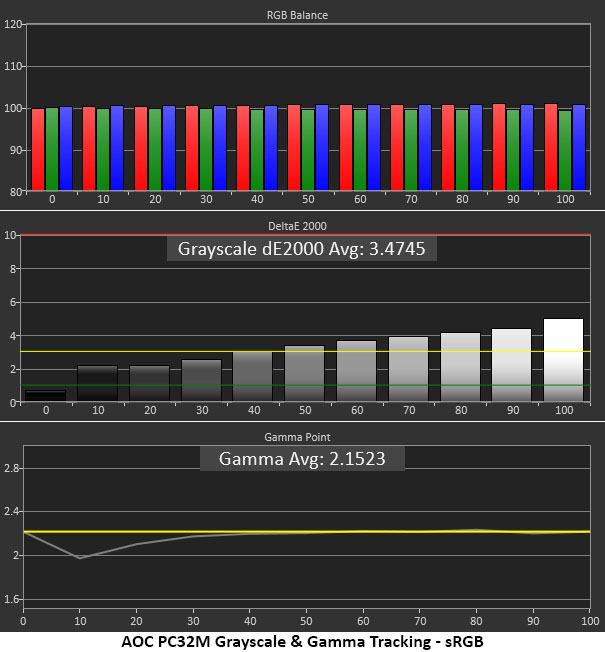
Most users will have no complaints about the PD32M’s default image. Grayscale is a tad warm, but that is an excusable error. Gamma is a little skewed with light shadows and slightly muted highlights. This disappears if you turn on the local dimming for SDR content. Though it’s on the edge, the PD32M doesn’t need to be calibrated.
But adjusting the RGB controls in the User color temp, and changing the gamma preset from 1 to 3, will make a visible improvement, albeit a small one. Perceived contrast is greater with gamma skewed in the other direction, darker shadows and brighter highlights. And grayscale is now visually perfect.
If you choose the smaller sRGB color gamut, it tracks well with a slight purple tint in the brighter steps. Gamma is right on the 2.2 reference line except for the 10 and 20% steps, which are too light. This makes shadow detail easier to see but makes blacks less dramatic.
Comparisons

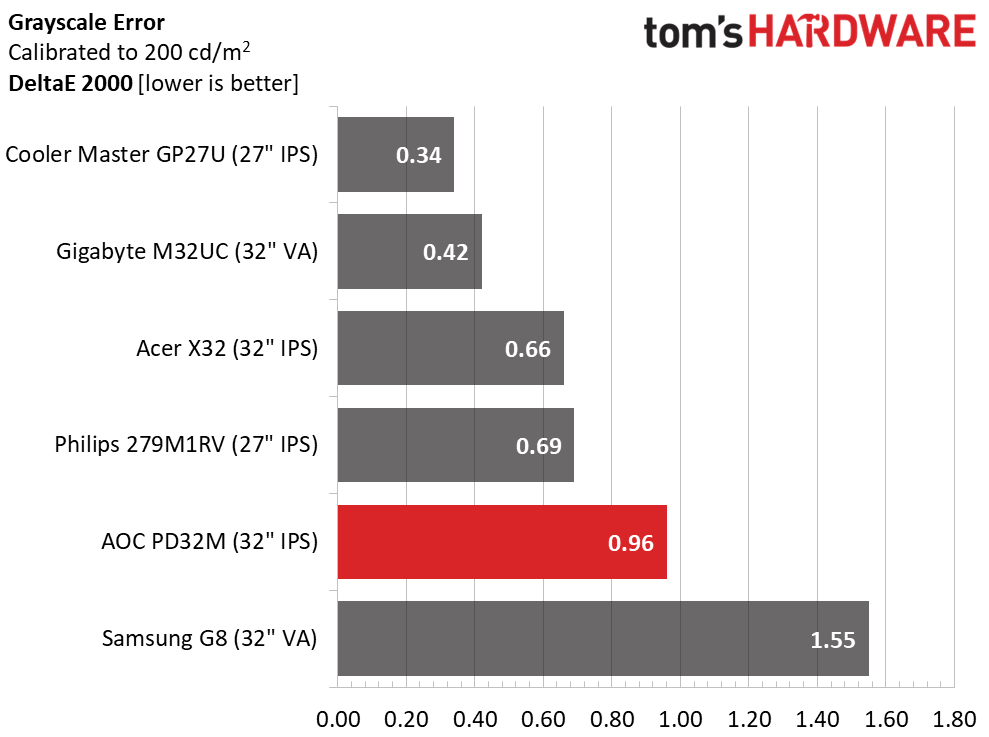
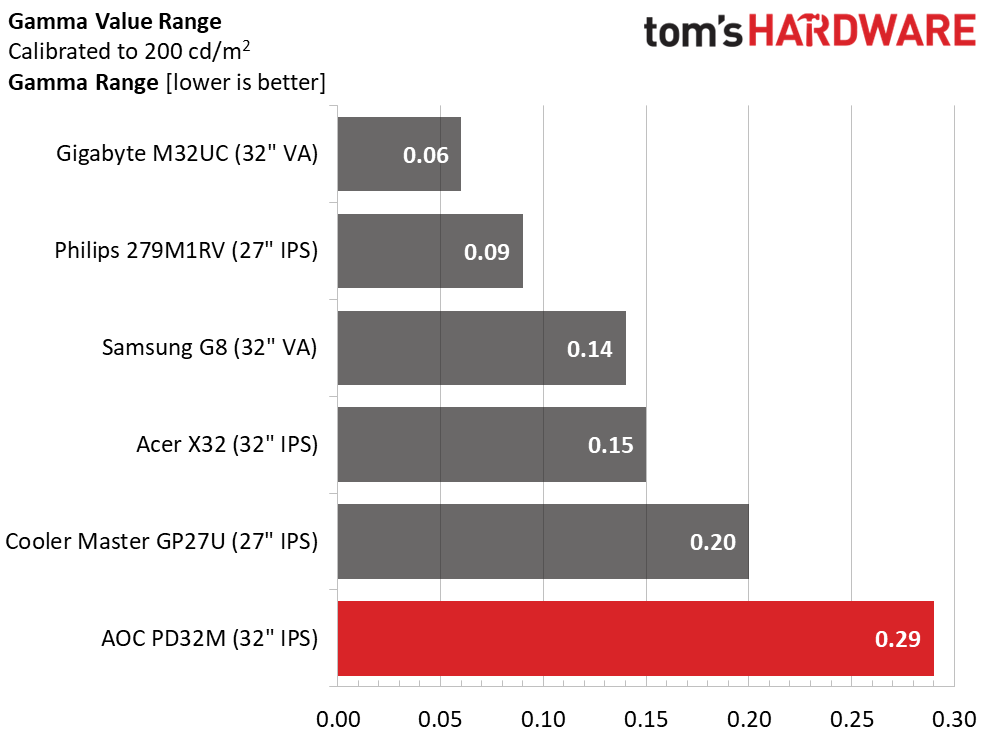

The PD32M is mid-pack both before and after calibration. This is not a slight when the calibrated grayscale error is only 0.96dE. However, that’s well below the visible threshold, so when showing actual content, all the monitors look the same.
Gamma tracking could use some improvement but by changing the preset from 1 to 3, I’ve flipped the error to make shadows deeper and highlights brighter. It’s a compromise, but one that improves picture quality. As always, I would prefer to see straight gamma tracking that rides the 2.2 line from bottom to top. Unfortunately, the PD32M is slightly off the mark.
Get Tom's Hardware's best news and in-depth reviews, straight to your inbox.
Color Gamut Accuracy
Our color gamut and volume testing use Portrait Displays’ Calman software. For details on our color gamut testing and volume calculations, click here.
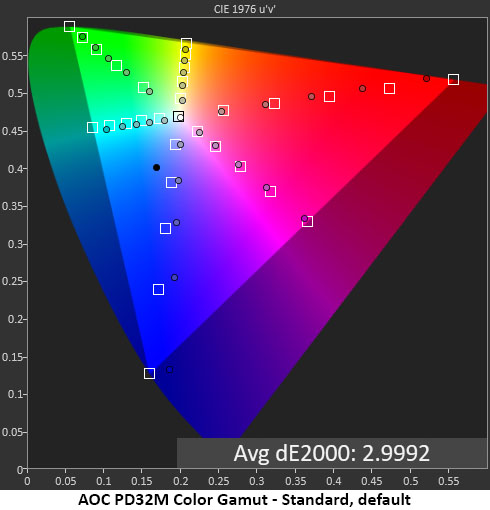
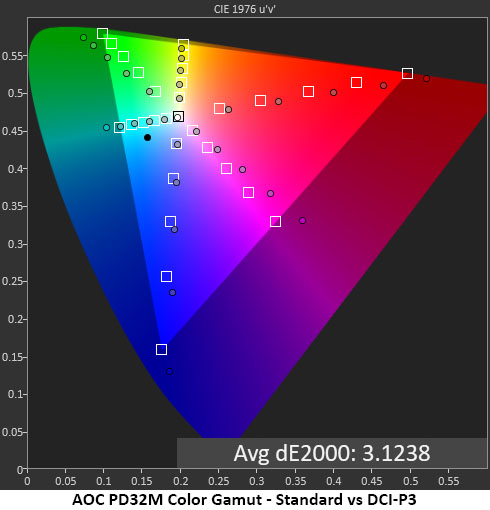
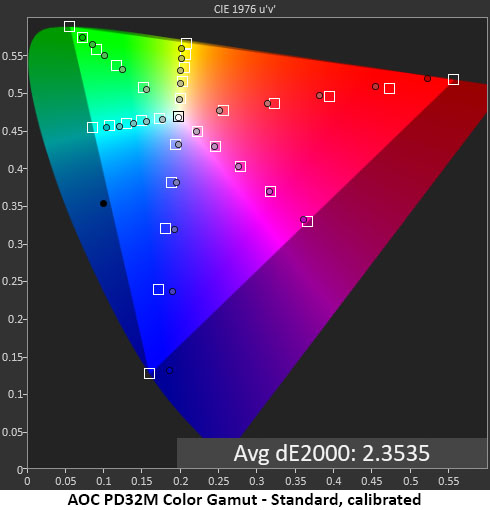

The PD32M has a tremendously large color gamut, and after a few initial tests, I determined that it is going for the Rec.2020 specification. You can see this by looking at the green primary. A DCI-P3 monitor will track green towards yellow, as illustrated in the second chart above. The PD32M does not do that.
Calibration barely makes a difference in color; the improvement comes mainly in grayscale and gamma tracking. But the color error is now a tad lower, which is always good. The takeaway is that the PD32M is a little under-saturated when measured against Rec.2020 and a little over-saturated when compared to DCI-P3.
The PD32M tracks the sRGB gamut very well, with only a tiny error and nearly full coverage. All measurement points are on their targets. There are no calibration options in this mode.
Comparisons


All the monitors here are premium displays, so it’s no wonder that the PD32M’s excellent color accuracy puts it in the middle. A 2.35dE average color error is excellent in any category. And the sRGB error is even lower at 1.72dE.
The PD32M is in an elite group of monitors that cover more than 100% of the DCI-P3 color gamut. While the top two screens cover even more, the visual difference is small. You will see a difference when viewing the smaller-gamut screens. The PD32M covers nearly 80% of Rec.2020 which is a lot of color. It only comes up a tad short in the red and green primaries and is one of the most colorful monitors I’ve yet tested.
MORE: Best Gaming Monitors
MORE: How We Test PC Monitors
MORE: How to Buy a PC Monitor
MORE: How to Choose the Best HDR Monitor
Current page: Grayscale, Gamma and Color
Prev Page Brightness and Contrast Next Page HDR Performance
Christian Eberle is a Contributing Editor for Tom's Hardware US. He's a veteran reviewer of A/V equipment, specializing in monitors. Christian began his obsession with tech when he built his first PC in 1991, a 286 running DOS 3.0 at a blazing 12MHz. In 2006, he undertook training from the Imaging Science Foundation in video calibration and testing and thus started a passion for precise imaging that persists to this day. He is also a professional musician with a degree from the New England Conservatory as a classical bassoonist which he used to good effect as a performer with the West Point Army Band from 1987 to 2013. He enjoys watching movies and listening to high-end audio in his custom-built home theater and can be seen riding trails near his home on a race-ready ICE VTX recumbent trike. Christian enjoys the endless summer in Florida where he lives with his wife and Chihuahua and plays with orchestras around the state.
-
UWguy Did April fools come twice this year? If this was OLED maybe it would justify the price but definitely not as is.Reply
Plus AOC? Gives me flashbacks to the 80’s with their crappy interference laden CRT monitors. -
oofdragon ReplyUWguy said:Did April fools come twice this year? If this was OLED maybe it would justify the price but definitely not as is.
Plus AOC? Gives me flashbacks to the 80’s with their crappy interference laden CRT monitors.
Well this is a advertising website, not a review one.. so you have these amazing products left and right. I do agree that as of today I wont buy a expensive monitor if it's not OLED. They say "but Mini led is brighter!! " Bro I turn brightness down the most I can, I don't want to look at a super bright lamp but at pure black, and make it 240Hz because today that's the new standard -
jakjawagon ReplyThere is no KVM switch, unfortunately.
Yes there is. The monitor's USB ports will connect via either the USB-C port or the USB-B upstream port, depending on which display input is active. Not the most elegant solution, but it's still technically a KVM.
A tiny dongle plugs into one of the USB ports to support the wireless remote.
I'm guessing you're mistaking the included USB stick containing drivers, manuals etc. for a dongle. The remote works fine without plugging it in. -
ra3tonite I have a 1440p monitor but I still play games at 1080p. A lot of games look really great 1080p when playing on a native 1080p monitor. But when I use my 1440p monitor and scale back to 1080p, I notice that the image is not as sharp as when just playing on a native 1080p monitor.Reply
I wonder if using a 4k monitor but scaling back to 1080p for games would have that same blurring effect? Not sure since 2160p to 1080p is a cleaner ratio compared to 1440p to 1080p. I'm not really sure how that stuff works, though. Any thoughts?
